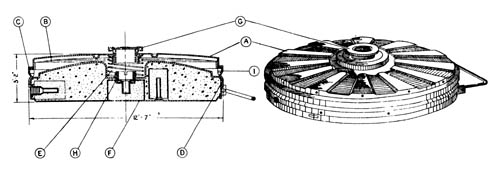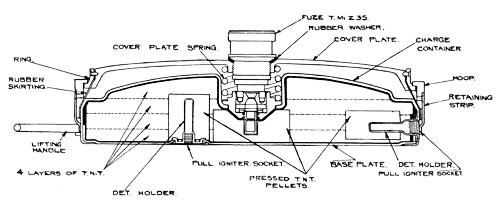
The design of the third type of Tellermine does not differ greatly from that of the other two models. It is distinguished by the radial flutings on the upper face (a), which extend to the edge of the surface. On the underside of this pressure plate (a) is a flat strengthening ring (b), spot-welded to the plate.
The ring (c) is secured to the body of the mine (d) by a number of punches. This ring retains the pressure plate in position against the spring (b). The rubber seal (i) between the body of the mine and the pressure plate protects the operating mechanism against moisture and dust.
The mine body and the base (f) are similar in construction to the type 1 T. Mi. 35, type 1 having an adapter to take an additional side igniter, which is located diametrically opposite the handle, and type 3 having an adapter for the base igniter. In the case of type 3, the igniter is screwed down until it rests on the rim of the socket (h), and the screw plug (g) is then not required.
The design for the mine appears to be a compromise between the Tellermine No. 1 and the Tellermine No. 2. In the former the whole of the mine cover forms the pressure plate and the mine is known to be subject to blast effects. The smaller area of the pressure plate in Tellermine No. 2 reduced the susceptibility of the mine to blast but at the same time reduced the available area for operating the mine.
SPECIFICATIONS
| Diameter | 12.75 ins. | |
| Height | 3.21 ins. | |
| Weight | 21.50 lb. | |
| Bursting charge | 66-34 Amatol | |
| weight | 13.9 lb. | |
| Booster pellets | 3 PETN |
German: p. 303
